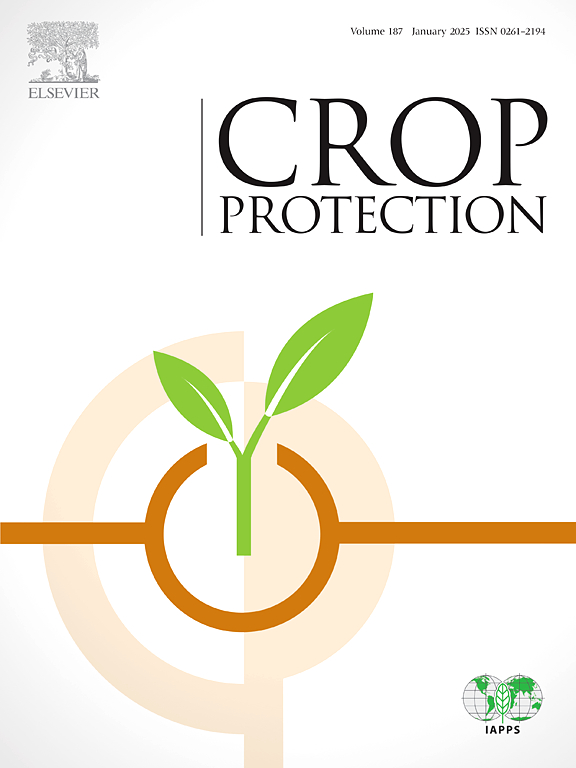在以保护性农业为基础的轮作中,覆盖作物和除草剂可控制紫花地丁(Cyperus rotundus L.)并提高作物产量
IF 2.5
2区 农林科学
Q1 AGRONOMY
引用次数: 0
摘要
在不同的农业生态中,采用保护性耕作(CA)方法会导致包括紫花地丁在内的多年生杂草逐渐占据主导地位。如果不对这种杂草进行有效管理,在小农耕作制度中成功采用保护性农业的可能性就相当小。因此,我们的目标是制定一项综合战略,在以 CA 为基础的作物轮作中管理香附子(C. rotundus)。本研究在印度坎普尔进行了为期两年(2020-21 年和 2021-22 年)的田间试验,采用三份重复的分块设计。在 CA 平台(免耕并添加作物秸秆)下,主小区的处理包括紫坚果穗苷管理方法,子小区的处理包括作物轮作。在夏季(4 月至 6 月)采用了六种管理方法,作为主小区,并与鸽子豆(Cajanus cajan (L.) Huth)-小麦(Triticum aestivum L.)和珍珠米(Pennisetum glaucum (L.) R.Br)-鹰嘴豆(Cicer arietinum L.)等两种作物轮作作为副小区叠加。在夏季种植覆盖作物 Sesbania(Sesbania aculeata (Willd.) Pers.)45 天,然后用 2,4-D 500 g a.i.Ha-1(栽培管理;Sesbania+2,4-D)和/或夏季灌溉,然后在灌溉后 20 天施用氟嘧磺隆 70 g a.i.Ha-1(栽培管理;Sesbania+2,4-D)和/或夏季灌溉。与传统方法(夏季犁地,然后灌溉并施用草甘膦 1.5 kg a.e.Ha-1)相比,灌溉后 20 天施用氟嘧磺隆(化学管理;氟嘧磺隆)可使腐霉利密度逐年降低 37-42% 和 23-64%。此外,在夏季,这些方法比传统方法(多年平均值)可降低 25-27% 的杂草总密度(p < 0.05)。重要的是,这些管理方法对降低雨季和冬季作物的轮叶黑麦草密度和杂草总密度具有持续影响。例如,与传统方法相比,谷硫磷 +2,4-D 和甲基吡嘧磺隆在雨季可分别减少 35% 和 15% 的腐竹密度。无论采用哪种轮作方式,石硫合剂+2,4-D 和氟嘧磺隆都能使轮纹草在冬季的密度(年平均值)比常规方法降低 30-40% (p < 0.05)。与传统方法相比,在芝麻+2,4-D 和氟嘧磺隆的作用下,轮纹草的干重在夏季明显减少了 13-23%,在雨季减少了 23-29%,在冬季减少了 55-72%。珍珠米-鹰嘴豆轮作比鸽子豆-小麦轮作的腐霉菌侵扰率低 10-35%(p < 0.05)。与常规方法相比,芝麻+2,4-D 和氟磺隆等管理方法在 2020-21 年的系统生产力提高了 15-19% (p < 0.05),在 2021-22 年提高了 5-7% (p > 0.05),平均提高了 10-12% (p > 0.05)。在 CA 系统中,雨季种植夏绿豆比种植芝麻+2,4-D 和甲基吡嘧磺隆分别增加了 45.2% 和 10.1% 的腐竹密度(p <0.05)。此外,雨季鸽子豆作物下这种杂草的密度比珍珠米作物下高 41.4%(多年平均值)。因此,在种植系统(珍珠米-鹰嘴豆和鸽子豆-小麦)中种植覆盖作物芝麻,然后用 2,4-D 击倒(芝麻 +2,4-D)和/或在夏季通过氟嘧磺隆进行除草剂管理,以及随后推荐的杂草管理方法,都能比传统方法减少轮纹甘蓝和所有杂草的侵扰。本文章由计算机程序翻译,如有差异,请以英文原文为准。
Cover crop and herbicides can control purple nutsedge (Cyperus rotundus L.) and increase crop yields in conservation agriculture-based crop rotations
Adoption of conservation agriculture (CA) practices can lead to the dominance of perennial weeds including purple nutsedge (Cyperus rotundus L.) in different agroecologies over time. Without effective management of this weed, successful adoption of CA in smallholder farming systems is rather unlikely. Therefore, we aimed to develop an integrated strategy for managing C. rotundus in CA-based crop rotations. This study encompassed a two-year (during 2020–21 and 2021–22) field experimentation at Kanpur, India with a split-plot design with three replications. The treatments included purple nutsedge management practices in main plot and crop rotations in sub-plot under CA platform (no-tilled with added crop residues). Six management options were adopted in the summer season (during April to June) as main plots that were super-imposed with two crop rotations such as pigeonpea (Cajanus cajan (L.) Huth) – wheat (Triticum aestivum L.) and pearlmillet (Pennisetum glaucum (L.) R.Br) – chickpea (Cicer arietinum L.) as sub-plot. Growing of cover crop Sesbania (Sesbania aculeata (Willd.) Pers.) during the summer season for 45 days followed by knockdown with 2,4-D 500 g a.i. Ha−1 (cultural management; Sesbania+2,4-D) and/or summer irrigation followed by application of halosulfuron-methyl 70 g a.i. Ha−1 at 20 days after irrigation (chemical management; halosulfuron-methyl) reduced the C. rotundus density by 37–42% and 23–64% over years, respectively, than conventional practice (ploughing during summer followed by irrigation and glyphosate 1.5 kg a.e. Ha−1 application). Besides, these practices could decrease 25–27% total weed density (p < 0.05) than conventional practice (mean of years) in summer season. Importantly, these management practices had a carry-over effect on reduction in density of C. rotundus and total weeds of rainy and winter season crops. For instance, Sesbania +2,4-D and halosulfuron-methyl decreased 35% and 15% density of C. rotundus, respectively, during rainy season than conventional practice. Irrespective of crop rotations, Sesbania +2,4-D and halosulfuron-methyl decreased 30–40% density of C. rotundus (mean of years) in winter season than conventional practice (p < 0.05). A significant reduction in dry weight of C. rotundus was recorded under Sesbania +2,4-D and halosulfuron-methyl in summer season by 13–23%, rainy season by 23–29%, and winter season by 55–72% than conventional practice. Pearlmillet-chickpea rotation had a 10–35% lower infestation of C. rotundus than pigeonpea-wheat (p < 0.05). Management practices such as Sesbania +2,4-D and halosulfuron-methyl had higher system productivity by 15–19% in 2020–21 (p < 0.05), 5–7% in 2021–22 (p > 0.05), and 10–12% in average (p > 0.05) than conventional practice. Summer mungbean cultivation increased 45.2% and 10.1% density of C. rotundus in rainy season over Sesbania +2,4-D and halosulfuron-methyl in CA system, respectively (p < 0.05). Furthermore, the density of this weed was significantly higher under pigeonpea crop during rainy season by 41.4% than under pearlmillet crop (mean of years). Therefore, system-based approaches such as growing of cover crop Sesbania followed by knockdown with 2,4-D (Sesbania +2,4-D) and/or herbicide-based management through halosulfuron-methyl during summer season and subsequently recommended weed management practices in cropping systems (pearlmillet – chickpea and pigeonpea – wheat) can reduce the infestation of C. rotundus and total weeds in CA than conventional practice.
求助全文
通过发布文献求助,成功后即可免费获取论文全文。
去求助
来源期刊

Crop Protection
农林科学-农艺学
CiteScore
6.10
自引率
3.60%
发文量
200
审稿时长
29 days
期刊介绍:
The Editors of Crop Protection especially welcome papers describing an interdisciplinary approach showing how different control strategies can be integrated into practical pest management programs, covering high and low input agricultural systems worldwide. Crop Protection particularly emphasizes the practical aspects of control in the field and for protected crops, and includes work which may lead in the near future to more effective control. The journal does not duplicate the many existing excellent biological science journals, which deal mainly with the more fundamental aspects of plant pathology, applied zoology and weed science. Crop Protection covers all practical aspects of pest, disease and weed control, including the following topics:
-Abiotic damage-
Agronomic control methods-
Assessment of pest and disease damage-
Molecular methods for the detection and assessment of pests and diseases-
Biological control-
Biorational pesticides-
Control of animal pests of world crops-
Control of diseases of crop plants caused by microorganisms-
Control of weeds and integrated management-
Economic considerations-
Effects of plant growth regulators-
Environmental benefits of reduced pesticide use-
Environmental effects of pesticides-
Epidemiology of pests and diseases in relation to control-
GM Crops, and genetic engineering applications-
Importance and control of postharvest crop losses-
Integrated control-
Interrelationships and compatibility among different control strategies-
Invasive species as they relate to implications for crop protection-
Pesticide application methods-
Pest management-
Phytobiomes for pest and disease control-
Resistance management-
Sampling and monitoring schemes for diseases, nematodes, pests and weeds.
 求助内容:
求助内容: 应助结果提醒方式:
应助结果提醒方式:


